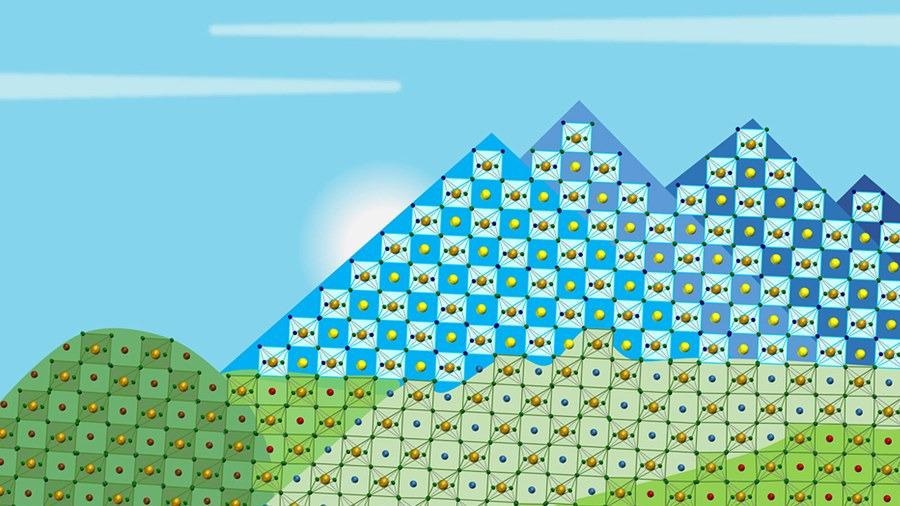Dec 7 2020
In the recent past, the group of supposed metal halide perovskites as materials has redefined the field of photovoltaics.
 Artistic representation of an ionic defect landscape in the perovskites. Image Credit: Dresden University of Technology.
Artistic representation of an ionic defect landscape in the perovskites. Image Credit: Dresden University of Technology.
From a general standpoint, metal halide perovskites are essentially crystalline materials that conform to the ABX3 structure, with a differing composition. In this case, A, B, and X can denote a combination of varied inorganic and organic ions.
Materials like these exhibit several properties that are perfect for use in solar cells and can help make optoelectronic devices, like photodetectors, light-emitting diodes (LEDs), or lasers, relatively more efficient. With respect to the development of an energy- and resource-efficient technology, the significance of studies on such materials is extremely high.
Metal halide perovskites have beneficial properties, such as high light-harvesting capacity and excellent potential to efficiently change solar energy into electrical energy. Another unique aspect of such materials is that both ions and charge carriers are mobile inside them.
Although charge carrier transport is a central process needed to enable the photovoltaic workings of the solar cell, ion transport and ionic defects usually have unwanted consequences on the performance of such devices.
In spite of considerable advancements in this domain of research, several questions with respect to the physics of ions in perovskite materials remain unresolved.
Toward a more improved interpretation of these kinds of structures, the Technical Universities of Chemnitz and Dresden have currently taken a major step forward.
In a collaborative investigation by the research teams headed by Dr Yana Vaynzof, Professor and Chair of Emerging Electronic Technologies at the Institute of Applied Physics and Center for Advancing Electronics Dresden–cfaed, Dresden University of Technology, and Dr Carsten Deibel, Professor of Optics and Photonics of Condensed Matter at the Chemnitz University of Technology, under the management of the Chemnitz University of Technology, both teams revealed the ionic defect landscape present in metal halide perovskites.
The team was able to detect crucial characteristics of the ions that constitute these kinds of materials. The movement of the ions leads to the presence of flaws in the material, which tend to have a negative impact on the stability and efficiency of perovskite solar cells.
The working team also observed that the movement of all visualized ions, in spite of their varied characteristics (like negative or positive charge), follows a standard transport mechanism and also helps assign ions and defects. This phenomenon is called the Meyer-Neldel rule.
The results of the study were published in the leading journal Nature Communications.
Probing the ionic defect landscape of perovskite materials is not a simple task. We needed to perform extensive spectroscopic characterization on perovskite samples in which the defects were intentionally introduced and their type and density were gradually tuned. Therefore, the expertise of both teams was invaluable.
Sebastian Reichert, Research Assistant, Chair of Optics and Photonics of Condensed Matter, Chemnitz University of Technology
Reichert is also the lead author of the publication.
Clarifying Basic Transport Mechanisms
One of the most important results of our study is the intricate interplay between the ionic and electronic landscapes in perovskite materials. By changing the density of the various ionic defects in perovskite materials, we observe that the built-in potential and the open-circuit voltage of the devices are affected.
Dr Yana Vaynzof, Professor and Chair of Emerging Electronic Technologies, Institute of Applied Physics and Center for Advancing Electronics Dresden, Dresden University of Technology
This demonstrates that defect engineering is a robust tool to improve the performance of perovskite solar cells further than the state of the art. The collaborative research work also found that all ionic defects fulfill the supposed Meyer-Neldel rule.
This is very exciting since it reveals fundamental information about the hopping processes of ions in perovskites. We currently have two hypotheses regarding the origin of this observation and we plan to investigate those in our future studies.
Dr Carsten Deibel, Professor of Optics and Photonics of Condensed Matter, Chemnitz University of Technology
Background: Cooperation of Chemnitz and Dresden in the DFG’s SPP 2196
The research team of Carsten Deibel is pioneering the field of impedance and deep-level transient spectroscopy—both are robust techniques for analyzing defects in semiconductor materials. The Yana Vaynzof’s team created a technique to influence and regulate the density and type of defects in perovskite materials by deliberately altering the stoichiometry of the solution from which they are deposited.
Such materials are subsequently used for producing solar cells, so that their spectroscopic characterization can be directly associated with their photovoltaic performance.
Both research groups are working on their collaborative project, called Perovskite Defects: Physics, Evolution and Stability (PERFECT PVs), as part of the German Research Foundation (DFG)’s Priority Program (SPP) 2196 Perovskite Semiconductors: From Fundamental Properties to Application.
Journal Reference:
Reichert, S., et al. (2020) Probing the ionic defect landscape in halide perovskite solar cells. Nature Communication. doi.org/10.1038/s41467-020-19769-8.